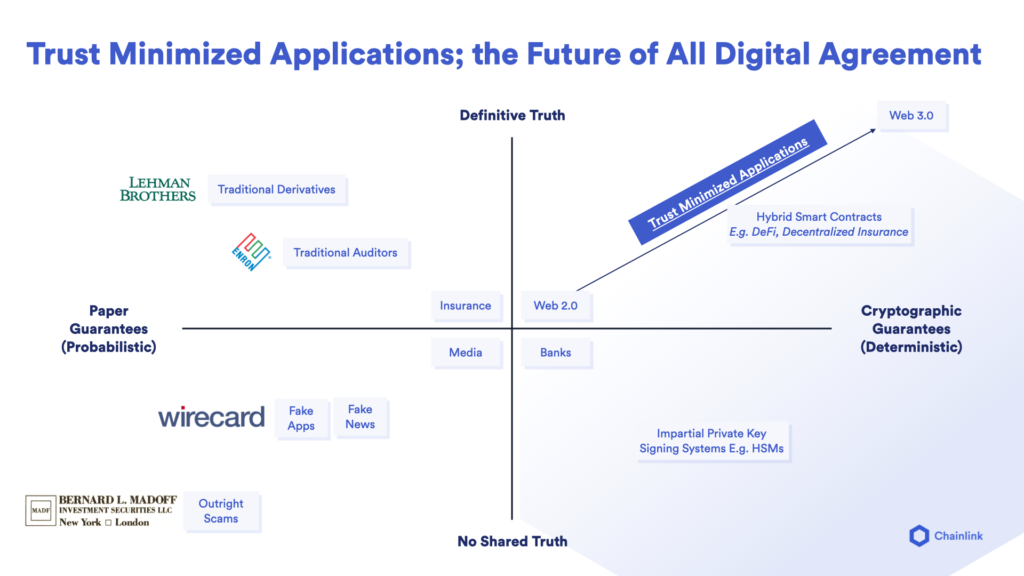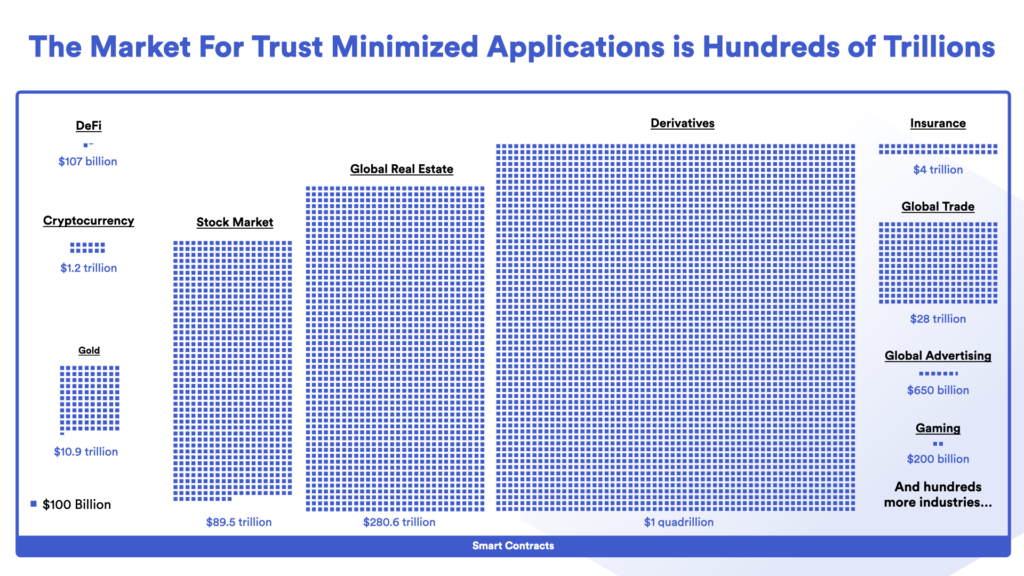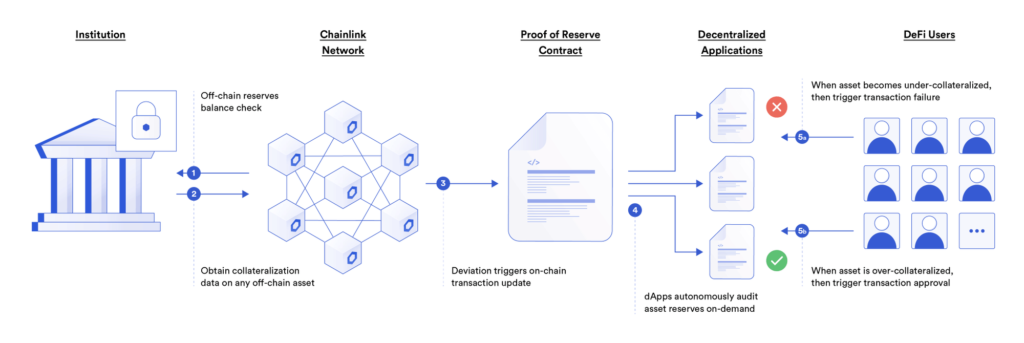Sergey Nazarov, Chainlink Co-founder, releases a new presentation called, ” Chainlink Economics 2.0 and the Market for Trust-Minimized Applications“. Here, Sergey talks about the need for trust-minimized applications and their importance for modern economic landscapes like decentralized finance (DeFi).
How Did Cryptographic Encryption Begin?
Years ago, few people understood what end-to-end encryption was or why it was needed when sending sensitive data over the internet or SMS. It was assumed by the public – much to their detriment – that big companies or government institutions would take care of private data. Now, however, even the average teenager and consumers know what end-to-end encryption is and why is it needed.
Sergey asks, what sparked the change? He believes that it is because the institutions—whether they were larger technology institutions, governmental institutions, or technology platform institutions in the form of Web2—failed. They failed their users, and those users lost faith in them as technology providers for communications. It was no longer acceptable for users to simply say, “Oh, it’s a big telecom, it’s safe.” Or, “Oh, don’t worry about it; nothing can ever go wrong if, you know, the government decides to look into every single message you ever sent.” Or any number of other kinds of very vague brand-based, paper-based guarantees.
Those guarantees fell away because of incidents like Cambridge Analytica, because of the misuse of various assumptions that users had about the privacy of their messaging data, and because of many cases where telecoms didn’t deliver the security and privacy that they promised.

The Need For A Cryptographically Guaranteed Society
Restoring these societal relationships and the guarantees around them is what our industry is about and what oracle networks are about. Chainlink and the general body of work on blockchains and smart contracts are about creating a cryptographically guaranteed society like we now have cryptographically guaranteed communications.
This transition to a cryptographically guaranteed society is going to happen through what we call trust-minimized applications.

There’s a wide spectrum of what makes an application trust-minimized. You can actually have a trust-minimized application that’s a web server that simply relies on blockchains, smart contracts, and oracle networks to prove certain things to users about what that web server can and can’t do. That is the beginning of being a trust-minimized application, and many Web2 applications are now becoming trust-minimized through solutions such as cryptographic data signing and provably fair RNG. There are also fully trust-minimized applications, which are DeFi smart contracts that are run on-chain and triggered by oracle networks, both of which are fully trust-minimized systems.
This transition to a cryptographically guaranteed society is what the Chainlink Network is about. The aim of Chainlink is to provide the infrastructure that creates trust-minimized applications and enables a transition to a cryptographically guaranteed society. A cryptographically guaranteed society means a global market for everything from commodities to equities to real estate derivatives to insurance agreements to global trade, advertising, gaming, ticket sales, and everything where you have a digital relationship: between you and a band, between you and a game, between you and an equity, between you and a commodity, between you and an insurance product, between you and a global trade partner.
These are all relationships that right now are not guaranteed, but they will all become cryptographically guaranteed. Just like end-to-end encrypted messaging is the new minimum standard for communications in society, cryptographically guaranteed relationships are the new minimum for how we interact with each other as peers, with each other through platforms, and even with each other through institutions.

Oracle Networks: Key Infrastructure for Trust-Minimized Apps
Chainlink oracle networks provide key infrastructure that enables Web2 systems to become trust-minimized applications and for Web3 systems to expand into new categories by making entirely new, fully trust-minimized applications. In this way, Chainlink can be understood as a new “truth infrastructure” for a society that expects cryptographic guarantees.
The first category of activity where Chainlink has done this is market data, which powers key DeFi verticals and continually expands and unlocks new on-chain markets. Chainlink Data Feeds have also been rapidly adopted across gaming, insurance, and other categories beyond decentralized finance.
Chainlink has also proven the utility of oracle networks for functions far beyond data delivery, such as off-chain computation. Chainlink VRF (Verifiable Random Function) is the standard source of random number generation in the Web3 economy across numerous blockchains. And just like we’ve seen Web2 systems using market data from Chainlink oracle networks, we are now starting to see an increasing number of Web2 gaming companies wanting to use the random numbers generated by the combination of oracle networks and blockchains to prove to their Web2 users that they are a reliable application—essentially to use encryption and cryptographic guarantees to prove that they are a trust-minimized application.
The same dynamic that we saw with the adoption of Chainlink-powered data driving the growth of DeFi, we now see with the adoption of Chainlink-powered random number generation leading to the massive influx of gaming into the blockchain industry. Moreover, Web2 companies are noticing that influx and deciding to leverage oracle networks to add a certain measure of cryptographic guarantees into their systems.

Stablecoins and wrapped tokens are crypto assets that have particularly realized the benefit of oracle networks, specifically for proof of reserves. Chainlink Proof of Reserve is continuing to become adopted by stablecoin providers and financial systems that want to create baskets of assets on-chain but need to prove the state of those assets off-chain. These use cases are powerful examples where having an oracle network that can come to consensus about something that a blockchain network cannot come to consensus about—namely the state of an off-chain asset—accelerates the creation and adoption of new smart contract use cases like more advanced stablecoins, more secure cross-chain assets, and more inflation-resistant systems.

These Chainlink-powered innovations ultimately feed into the virtuous cycle of oracle networks providing key infrastructure for trust-minimized applications, and trust-minimized applications achieving greater collective consciousness as an option—the superior option for users who expect not just promises around technology platforms and digital relationships, but guarantees.
Via this site

